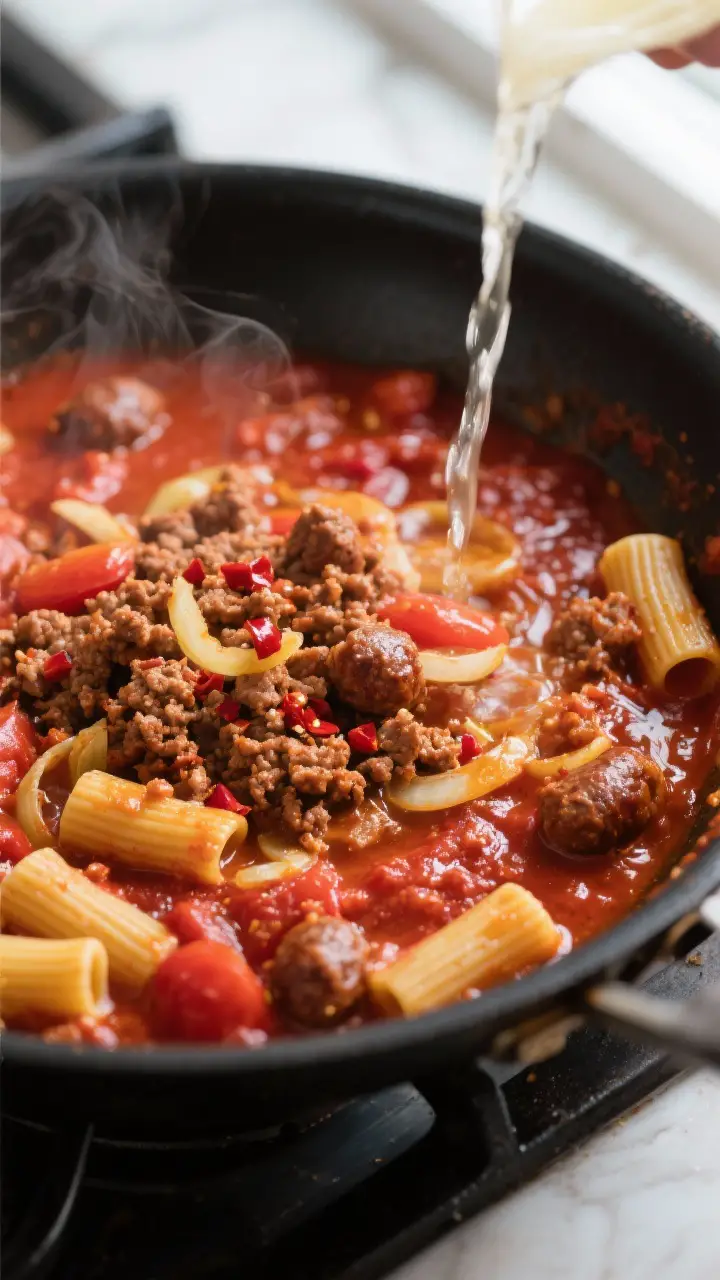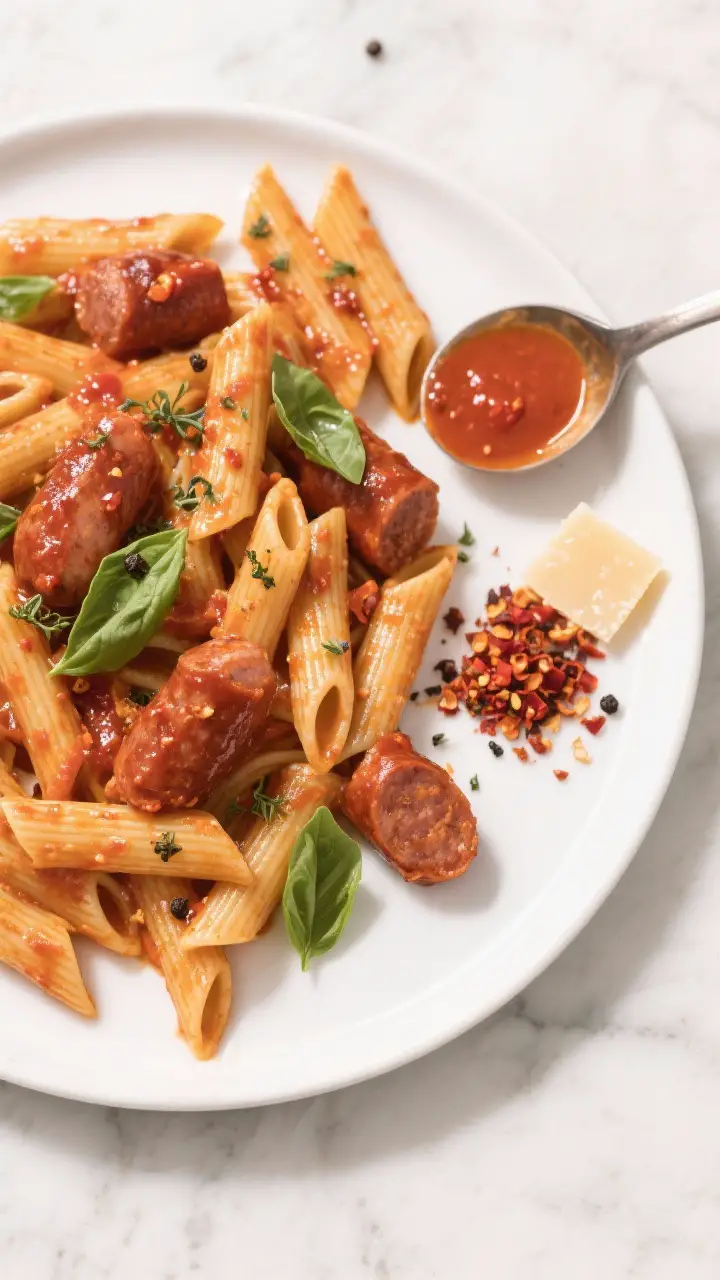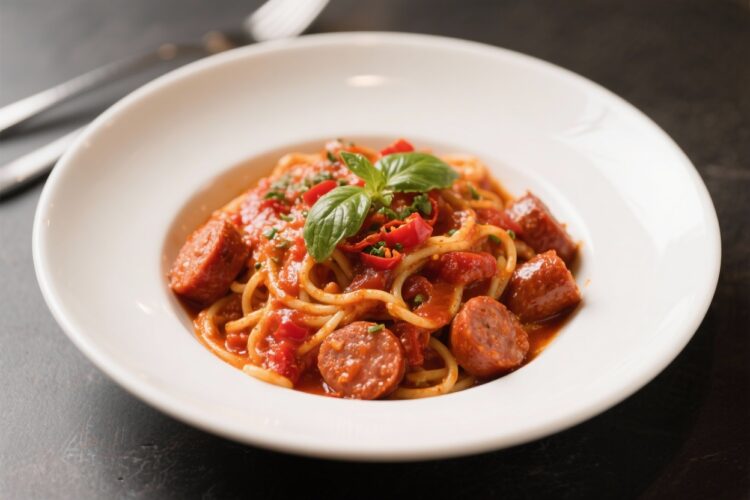Arrabbiata sauce is all about heat, brightness, and simple pantry staples that punch above their weight. Add Italian sausage, and you’ve got a weeknight-friendly pasta that tastes like a cozy trattoria meal. This version keeps the fiery personality of arrabbiata while layering in savory richness from browned sausage.
It’s fast enough for a Tuesday and special enough for guests. If you like bold flavors without a lot of fuss, this is your kind of dinner.
Why This Recipe Works

The base is classic arrabbiata: good tomatoes, plenty of garlic, and crushed red pepper. Browning the sausage first releases flavorful fat that infuses the onions and garlic and gives the sauce deeper character.
A splash of pasta water helps the sauce cling to the noodles, creating that silky, restaurant-style finish. Fresh basil and a touch of olive oil at the end brighten everything so the heat doesn’t feel heavy. The result is balanced: spicy, savory, and fresh.
Shopping List
- Italian sausage: 1 lb (sweet or hot; casings removed)
- Olive oil: 2–3 tablespoons
- Yellow onion: 1 small, finely diced
- Garlic: 5–6 cloves, thinly sliced or minced
- Crushed red pepper flakes: 1–2 teaspoons (adjust to taste)
- Tomato paste: 1 tablespoon
- Crushed tomatoes: 1 can (28 oz), preferably San Marzano
- Dry red wine (optional): 1/4 cup
- Granulated sugar (optional): Pinch, only if the tomatoes are very acidic
- Kosher salt and black pepper: To taste
- Dried oregano: 1/2 teaspoon (optional)
- Fresh basil: 1/2 cup, torn
- Parmesan or Pecorino Romano: For serving
- Pasta: 12–16 oz (penne, rigatoni, or mezzi rigatoni work best)
- Pasta cooking water: Reserved, about 1 cup
- Lemon zest (optional): 1/2 teaspoon, for brightness
Instructions

- Prep your ingredients. Dice the onion, slice the garlic, and remove the sausage from its casing.
Tear the basil and grate the cheese. Bring a large pot of salted water to a boil for the pasta.
- Brown the sausage. Heat 1 tablespoon olive oil in a large skillet over medium-high. Add the sausage, breaking it up with a spoon.
Cook until well browned and cooked through, 6–8 minutes. Transfer to a plate, leaving the flavorful fat in the pan.
- Soften the aromatics. Reduce heat to medium. If the pan looks dry, add a splash more olive oil.
Add the onion and a pinch of salt. Cook until translucent and lightly golden, 4–5 minutes.
- Bloom the garlic and chili flakes. Stir in the garlic and crushed red pepper flakes. Cook 30–60 seconds until fragrant.
Don’t let the garlic brown.
- Toast the tomato paste. Add the tomato paste and cook, stirring, 1–2 minutes until it darkens slightly. This deepens the sauce’s flavor.
- Deglaze. Pour in the red wine (if using) and scrape up any browned bits. Let it reduce by half, about 1 minute.
- Add the tomatoes. Stir in the crushed tomatoes and oregano (if using).
Return the sausage and any juices to the pan. Simmer on low for 12–15 minutes, stirring occasionally.
- Cook the pasta. While the sauce simmers, cook pasta until just shy of al dente. Reserve about 1 cup of starchy cooking water before draining.
- Marry pasta and sauce. Add the drained pasta to the sauce with a splash of pasta water.
Toss over medium heat for 1–2 minutes until glossy and well-coated. Add more pasta water as needed for a silky texture.
- Finish and season. Taste and adjust salt, pepper, and heat. If the sauce is too sharp, add a tiny pinch of sugar.
Stir in torn basil, a drizzle of olive oil, and lemon zest if you like a bright finish.
- Serve. Plate with grated Parmesan or Pecorino. Add extra chili flakes for those who want more heat.
Keeping It Fresh
Store leftovers in an airtight container for up to 4 days. The flavor actually improves as the sauce settles.
Reheat gently on the stove with a splash of water to loosen it. If you’re freezing, cool the sauce completely and freeze it without pasta for up to 3 months. Cook fresh pasta when you’re ready to eat, then combine with reheated sauce for the best texture.

Health Benefits
Tomatoes bring lycopene, an antioxidant that supports heart health.
Garlic and onions offer compounds that may benefit immunity and circulation. Using lean Italian sausage or turkey sausage lowers saturated fat while keeping the dish satisfying. Choosing whole-wheat pasta adds fiber, which helps with fullness and steady energy.
You can also stir in a handful of spinach or steamed broccoli for extra nutrients without changing the flavor profile.
What Not to Do
- Don’t boil the sauce hard. A gentle simmer keeps flavors balanced and prevents splattering.
- Don’t skip browning. Pale sausage means less flavor. Get real color for that savory depth.
- Don’t overcook the pasta. Slightly under al dente is perfect before finishing in the sauce.
- Don’t burn the garlic. Bitter garlic will overpower everything. Keep the heat controlled.
- Don’t forget pasta water. It’s the key to a cohesive, glossy sauce that clings.
Alternatives
- Protein swap: Try spicy turkey sausage, chicken sausage, or crumbled plant-based sausage.
For a lighter option, skip sausage and add sautéed mushrooms.
- Heat levels: Use 1/2 teaspoon chili flakes for mild, 1 teaspoon for medium, and up to 2 teaspoons for fiery. Calabrian chili paste works beautifully too.
- Tomato options: Whole peeled tomatoes crushed by hand give a rustic texture. Passata yields a smoother sauce.
- Herb twist: Basil is classic, but a little fresh parsley adds a clean finish.
Avoid heavy dried herb blends that muddy the bright flavor.
- Pasta shapes: Penne and rigatoni are traditional. Fusilli or casarecce also grab sauce well. Use gluten-free pasta if needed.
- Dairy-free serving: Skip the cheese and finish with extra-virgin olive oil and more basil for richness.
FAQ
Can I make it less spicy?
Yes.
Start with 1/4 to 1/2 teaspoon of red pepper flakes and add more at the end if needed. You can also balance heat with a pat of butter or a splash of cream, though that nudges it away from classic arrabbiata.
What’s the best sausage to use?
Use quality Italian sausage from a butcher or a trusted brand. Sweet sausage keeps the heat focused on the sauce, while hot sausage layers in extra spice.
Either works; choose based on your heat tolerance.
Can I make the sauce ahead?
Absolutely. The sauce tastes even better the next day. Store it in the fridge and cook fresh pasta when you’re ready to serve, then combine in a pan with a splash of pasta water.
Do I need wine?
No.
Wine adds depth, but the sauce is great without it. If skipping, you can deglaze with a bit of broth or water.
Why add pasta water?
Starchy pasta water helps emulsify the sauce with the fat from the sausage and olive oil. It creates a silky texture and helps the sauce cling to the pasta.
Can I use pre-grated cheese?
You can, but freshly grated Parmesan or Pecorino melts better and tastes cleaner.
Pre-grated often contains anti-caking agents that affect texture.
How do I make it vegetarian?
Use a plant-based sausage or leave it out. Add sautéed mushrooms or roasted eggplant for hearty texture. The rest of the recipe stays the same.
What side dishes go well?
A simple green salad with lemon vinaigrette, garlicky sautéed greens, or roasted asparagus pair nicely.
Warm crusty bread is great for extra sauce.
Can I double the recipe?
Yes. Use a larger pot so the sauce has room to reduce slightly. When tossing with pasta, work in batches so everything coats evenly.
Why is my sauce watery?
It likely needs more simmer time or you added too much pasta water.
Let it reduce gently and toss until the sauce clings. Taste and adjust salt to bring flavors forward.
Final Thoughts
Spicy Arrabbiata with Sausage proves that a handful of good ingredients can deliver big flavor. Browning the sausage, blooming the aromatics, and using pasta water are the small steps that make it stand out.
Keep the heat where you like it, finish with fresh basil, and serve it hot with a shower of cheese. It’s simple, bold, and deeply satisfying—exactly what a great weeknight pasta should be.
Printable Recipe Card
Want just the essential recipe details without scrolling through the article? Get our printable recipe card with just the ingredients and instructions.

